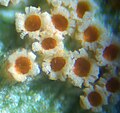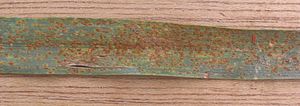Aeciospores are one of several different types of spores formed by rusts. They each have two nuclei and are typically seen in chain-like formations in...
2 KB (141 words) - 15:56, 20 October 2023
generally dark brown. Fungi portal Chlamydospore Urediniomycetes Pycniospore Aeciospore Teliospore Ustilaginomycetes Rust fungus: Spores C.J. Alexopolous, Charles...
3 KB (93 words) - 20:42, 20 October 2023
rise to a four-celled basidium with haploid basidiospores. Fungi portal Aeciospore Chlamydospore Pycniospore Rust fungus § Spores Urediniomycetes Urediniospore...
2 KB (189 words) - 20:03, 7 January 2024
aecia, which form dikaryotic aeciospores in dry chains in inverted cup-shaped bodies embedded in host tissue. These aeciospores then infect the second host...
31 KB (3,281 words) - 18:34, 30 September 2024
reproductive structure found in some plant pathogenic rust fungi that produce aeciospores. Aecia may also be referred to as "cluster cups". The term aecidium (plural...
1 KB (127 words) - 05:46, 13 December 2022
From Latin "adhaerere" Aeaea Ææa Eëä From Greek Αἰαία (Aiaíā) aeciospore æciospore aeciospore Neo-Latin aecium from Ancient Greek αἰκία (aikía, “injury,...
34 KB (979 words) - 12:11, 30 October 2024
Juniper is the winter host and pear is the summer host. Spores (called aeciospores) are produced from the fungal lantern-shaped growths which protrude from...
6 KB (640 words) - 04:48, 10 January 2024
apple leaves or surrounding the pycnia on the fruit. The aecia produce aeciospores. The wind carries the spores back to eastern red cedars, completing the...
14 KB (1,599 words) - 15:56, 1 May 2024
it infects Taraxacum species and Carex capillaris. Pycniospores and aeciospores are found on Taraxacum sp., and uredospores and teliospores are found...
2 KB (95 words) - 06:30, 14 May 2024
Pycnidia. These serve mainly as haploid gametes in heterothallic rusts. I-Aeciospores from Aecia. These serve mainly as non-repeating, dikaryotic, asexual...
30 KB (3,320 words) - 10:22, 26 September 2024









